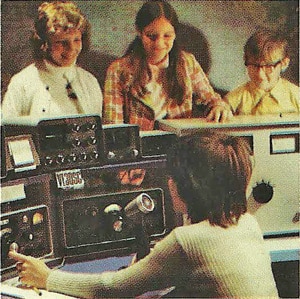OSC has closed
21 June 2024: The Government of Ontario, which has been eager to close the Ontario Science Centre and use the land (which it does not own) for housing, announced that the facility would close permanently today, due to fears that the roof could collapse. This is a very sad end to what was once a world-class interactive science museum.
24 June 2024: Ontario Science Centre doesn’t require full closure: A close reading of the engineers’ report

Operating VE3OSC was a dream come true for any ham radio operator. Picture c1969, Ontario Science Centre

A 1973 QSL card showing Big Bertha
As a very new amateur radio operator in the early 1970s, I was privileged to be one of the regular operators at VE3OSC, a display station at the Ontario Science Centre in Toronto, Canada.
The Science Centre opened in 1969 and it was a spectacular hands-on celebration of science. No expense was spared in its construction, and that certainly applied to the amateur radio exhibit.
The main operating desk featured a Collins S/Line station – considered the finest equipment of its era – which was mated to a Telrex ‘Big Bertha’ antenna system, the sort of antenna owned by millionaire ‘hams’.
I usually operated VE3OSC on Sunday afternoons. I always looked forward to it, since I got to talk to so many visitors to the centre about amateur radio, and the equipment was so much better than what I could afford. Even using single sideband was a thrill, as I had only an AM and CW transmitter at home.
VE3OSC was located in the Hall of Space, which was one of the hottest attractions at the Science Centre, in the wake of the Apollo moon landing.
» QSL cards from VE3OSC
» VE3OSC anecdotes and mysteries

Visitors to the Ontario Science Centre could watch the VE3OSC amateur radio station in operation. Photo c1969: Ont Science Centre
HF operating position

The HF station at VE3OSC c1969, showing the teletype machine at far left. In the early 1970s it was moved to the front railing of the station so visitors could watch messages being printed. Photo: Ont Science Centre
The equipment in the photo above comprises (left to right):
- Collins 30S-1 kilowatt amplifier (this was later replaced by a custom-built amplifier)
- Terminal unit for teletype (I think) on top of the 30S-1
- Rotation control for the Big Bertha antenna array (on top of 30S-1)
- Collins 516F-2 power supply (not visible)
- Collins DL-1 dummy load
- Collins 32S-3 transmitter
- Collins 312B-4 station control
- Tymeter Numechron 24-hour digital clock (on top of the 312B-4)
- Collins 51S-1 receiver
- Hallicrafters HA-1 electronic keyer
and in front of the equipment:
- Collins SM-2 desk microphone (later replaced by a Shure 444)
- J-38 straight telegraph key
- Vibroplex Vibrokeyer paddle

Les Popelyak VE3CCP, an OSC employee, operating VE3OSC, c1969. Les died 20 January 2021, age 83. Photo: Ont Science Centre
Not shown:
- Telrex ‘Big Bertha’ antenna array. This was a US-built self-supporting rotatable tubular steel mast with monoband yagis for 40m, 20m, 15m and 10m. It was the ultimate antenna system of its time, standing over 100′ tall. US Senator Barry Goldwater K7UGA had one too.
- Hy-Gain TH6DXX tri-band yagi on a guyed tower
- Wire antennas for lower frequencies
- Robot SSTV (slow-scan television) system (added later)
- Patch panel for antenna selection on the rear wall of the station.

Les Popelyak VE3CCP tuning the 51S-1 at VE3OSC, c1969. Photo: Ont Science Centre

Operators at VE3OSC c1969 showing the ’round emblem’ Collins 51S-1 general coverage receiver. Photo: Ont Science Centre
VHF operating position
- A modified FM business transceiver operating on 2 channels in the 2-metre band.
- I think the 2 channels were 146.34/146.94 (VE3RPT) and 146.94 simplex. Anyone remember?
The mid 1970s

VE3OSC, c1974
At some time in the mid 1970s, the station was rearranged. In the photo at right, the 51S-1 receiver is on the left, with the 32S-3 transmitter in the middle, and a home-brew linear amplifier at the right. There is also a Heathkit SB-610 monitor scope and a Heathkit watt meter.
Does anyone know the reason for replacing the Collins 30S-1 amplifier? I am guessing that it may have been too tricky to tune.
But I also recall that we were urged not to run high power, as it would interfere with the security guards’ walkie-talkies. We really didn’t need high power anyway, thanks to the very good antennas.
The end
Sadly, amateur radio station VE3OSC was dismantled and the pieces dispersed, possibly in the late 1970s. I’ve heard that a helicopter was used to take down some of the big antennas, and the Big Bertha mast is certainly long-gone. Years later, the station was re-established using Japanese equipment, but the location wasn’t as nice and the station’s effectiveness was limited by an extremely high level of interference caused by poorly installed ventilation fan controllers in the Science Centre.
If you can contribute information, corrections or photos, please contact me.
And finally, a thank you to all those hams who worked so hard to make the station a reality. It was a fantastic demonstration of the magic of radio.
Who knows where that nice equipment ended up, but I’m pleased to have some Collins gear in my current ham shack: Amateur Radio Station ZL1NZ




